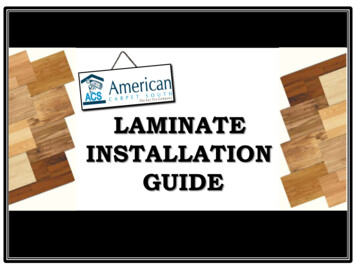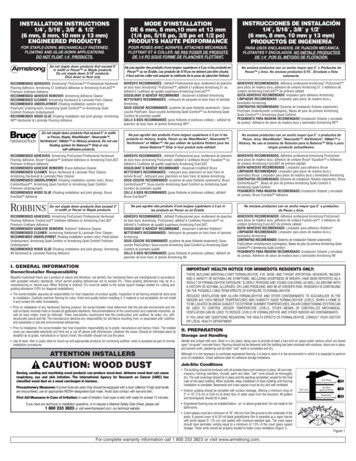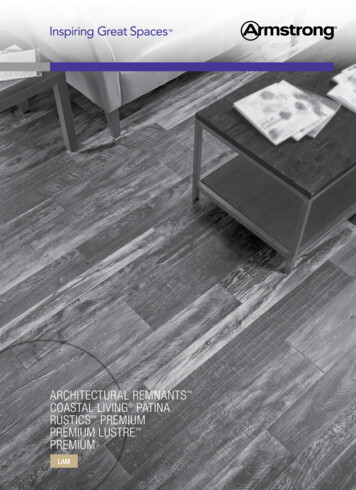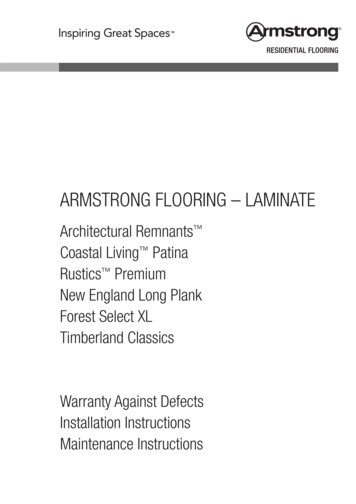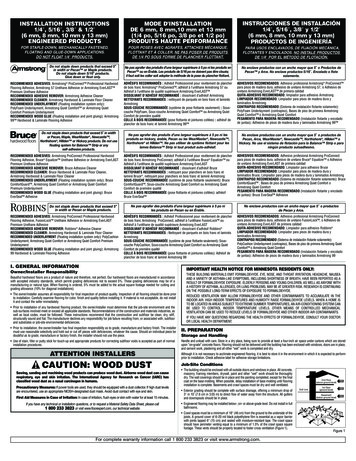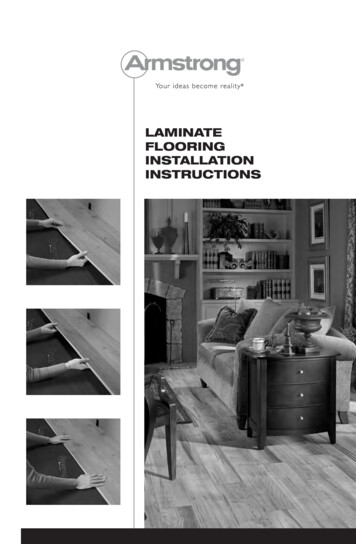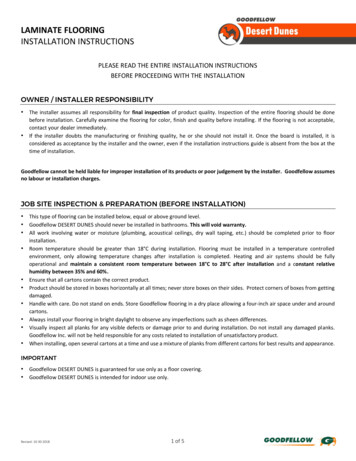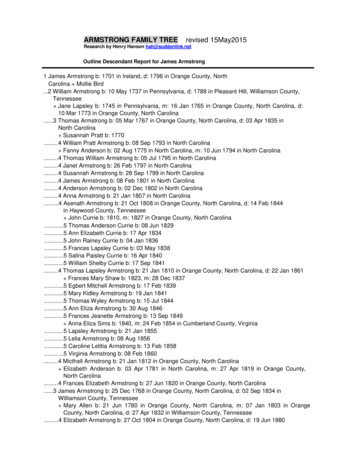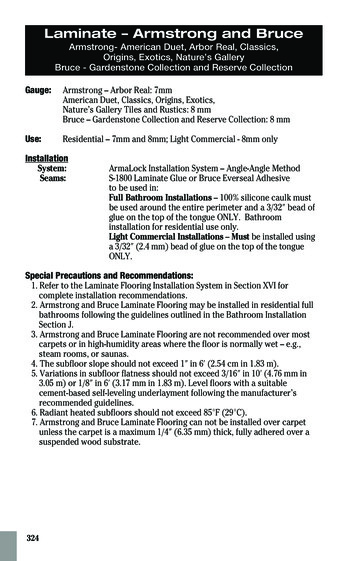
Transcription
Laminate – Armstrong and BruceArmstrong- American Duet, Arbor Real, Classics,Origins, Exotics, Nature’s GalleryBruce - Gardenstone Collection and Reserve CollectionGauge:Armstrong – Arbor Real: 7mmAmerican Duet, Classics, Origins, Exotics,Nature’s Gallery Tiles and Rustics: 8 mmBruce – Gardenstone Collection and Reserve Collection: 8 mmUse:Residential – 7mm and 8mm; Light Commercial - 8mm onlyInstallationSystem:Seams:ArmaLock Installation System – Angle-Angle MethodS-1800 Laminate Glue or Bruce Everseal Adhesiveto be used in:Full Bathroom Installations – 100% silicone caulk mustbe used around the entire perimeter and a 3/32″ bead ofglue on the top of the tongue ONLY. Bathroominstallation for residential use only.Light Commercial Installations – Must be installed usinga 3/32″ (2.4 mm) bead of glue on the top of the tongueONLY.Special Precautions and Recommendations:1. Refer to the Laminate Flooring Installation System in Section XVI forcomplete installation recommendations.2. Armstrong and Bruce Laminate Flooring may be installed in residential fullbathrooms following the guidelines outlined in the Bathroom InstallationSection J.3. Armstrong and Bruce Laminate Flooring are not recommended over mostcarpets or in high-humidity areas where the floor is normally wet – e.g.,steam rooms, or saunas.4. The subfloor slope should not exceed 1″ in 6′ (2.54 cm in 1.83 m).5. Variations in subfloor flatness should not exceed 3/16″ in 10′ (4.76 mm in3.05 m) or 1/8″ in 6′ (3.17 mm in 1.83 m). Level floors with a suitablecement-based self-leveling underlayment following the manufacturer’srecommended guidelines.6. Radiant heated subfloors should not exceed 85 F (29 C).7. Armstrong and Bruce Laminate Flooring can not be installed over carpetunless the carpet is a maximum 1/4″ (6.35 mm) thick, fully adhered over asuspended wood substrate.324
Laminate – Armstrong and BruceArmstrong- Cumberland and Woodland ParkBruce - Heritage Heights and American HomeGauge:Armstrong – Cumberland and Woodland Park: 7mmBruce – Heritage Heights: 7 mm; American Home: 8 mmUse:Residential – 7mm and 8mm; Light Commercial - 8mm onlyInstallationSystem:Seams:ArmaLock Installation System – Compac Lock, Angle-AngleMethod, which requires a higher angle (Approx. 45 ).S-1800 Laminate Glue or Bruce Everseal Adhesiveto be used in:Full Bathroom Installations - 100% silicone caulk must beused around the entire perimeter and a 3/32″ (2.4 mm)bead of glue on the top of the tongue ONLY. Bathroominstallation for residential use only.Light Commercial Installations – Must be installed usinga 3/32″ (2.4 mm) bead of glue on the top of the tongueONLY.Special Precautions and Recommendations:1. Refer to the Laminate Flooring Installation System in this section forcomplete installation recommendations.2. Armstrong and Bruce Laminate Flooring may be installed in residential fullbathrooms following the guidelines outlined in the Bathroom InstallationSection J.3. Armstrong and Bruce Laminate Flooring are not recommended over mostcarpets or in high-humidity areas where the floor is normally wet – e.g.,steam rooms, or saunas.4. The subfloor slope should not exceed 1″ in 6′ (2.54 cm in 1.83 m).5. Variations in subfloor flatness should not exceed 3/16″ in 10′ (4.76 mm in3.05 m) or 1/8″ in 6′ (3.17 mm in 1.83 m). Level floors with a suitablecement-based self-leveling underlayment following the manufacturer’srecommended guidelines.6. Radiant heated subfloors should not exceed 85 F (29 C).7. Armstrong and Bruce Laminate Flooring can not be installed over carpetunless the carpet is a maximum 1/4″ (6.35 mm) thick, fully adhered over asuspended wood substrate.325
LaminateArmstrong Pacific HeightsGauge:Armstrong – Pacific Heights: 8mmUse:Residential, Light CommercialInstallationSystem:Seams:ArmaLock Installation System– Lock and Fold MethodS-1800 Laminate Glue to be used in:Full Bathroom Installations – 100% silicone caulk mustbe used around the entire perimeter and a 3/32″ (2.4 mm)bead of glue on the top of the tongue ONLY. Bathroominstallation for residential use only.Light Commercial Installations – Must be installed usinga 3/32″ (2.4 mm) bead of glue on the top of the tongueONLY.Special Precautions and Recommendations:1. Refer to the Laminate Flooring Installation System in this section forcomplete installation recommendations.2. Armstrong Laminate Flooring may be installed in residential full bathroomsfollowing the guidelines outlined in the Bathroom Installation Section J.3. Armstrong Laminate Flooring is not recommended over most carpets or inhigh-humidity areas where the floor is normally wet – e.g., steam rooms,or saunas.4. The subfloor slope should not exceed 1″ in 6′ (2.54 cm in 1.83 m).5. Variations in subfloor flatness should not exceed 3/16″ in 10′ (4.76 mm in3.05 m) or 1/8″ in 6′ (3.17 mm in 1.83 m). Level floors with a suitablecement-based self-leveling underlayment following the manufacturer’srecommended guidelines.6. Radiant heated subfloors should not exceed 85 F (29 C).7. Armstrong Laminate Flooring can not be installed over carpet unless thecarpet is a maximum 1/4″ (6.35 mm) thick, fully adhered over a suspendedwood substrate.326
S-1800 Laminate Floor Glue! CAUTIONS-1800EYE AND SKIN IRRITANTINSTALLATION:DESCRIPTION:Flooring, Residential Type: Laminate Flooring,Light CommercialColor: LaminatePRODUCTS: Armstrong7mm:Arbor RealBayberryCumberlandWoodland Park Armstrong 8mm:AmbrosiaBeyondClassicsGalway Stone CreekForresterNature’s GalleryOriginsPacific Heights Bruce 7mm:Heritage Heights Collection Bruce 8mm:American Home CollectionGardenstone CollectionReserve CollectionPolyvinyl acetatecross-linking emulsion(water based)White when wet; driesopaque in 1 hour; Containsno visible taggantsApplicator:Predrilled cap on16 oz. BottleSpread Rate:3/32″ (2.4 mm) bead up to150 sq. ft. (500 lin. ft.)Removal from Wet: Use clean white clothSurface:dampened with warmwater. Dry: Can be easilypeeled away. Remove withcloth dampened with 8 oz.(1 cup) white distilledvinegar to 1 Gal. water(1:16 ratio)Shelf Life:One year if unopenedAvailable Units: Single unit 16 oz. BottleAdvantages:Nonflammable; specificallydesigned to create astrong, water-resistantbond between the tongueand groove; Use forLaminate installations inresidential full bathrooms,high moisture areas andlight commercialenvironments;easy clean up.327
Bruce Everseal Adhesive! CAUTIONEVERSEAL EYE AND SKIN IRRITANTINSTALLATION:DESCRIPTION: LaminateType:Flooring, Residential Laminate Flooring,Light CommercialPRODUCTS: Armstrong7mm:Arbor RealBayberryCumberlandWoodland Park Armstrong 8mm:AmbrosiaBeyondClassicsGalway Stone CreekForresterNature’s GalleryOriginsPacific Heights Bruce 7mm:Heritage Heights Collection Bruce 8mm:American Home CollectionGardenstone CollectionReserve Collection328Polyvinyl acetatecross-linking emulsion(water based)Color:White when wet; driesopaque in 1 hour;Contains no visibletaggantsApplicator:Predrilled cap on16 oz. BottleSpread Rate:3/32″ (2.4 mm) bead up to150 sq. ft. (500 lin. ft.)Removal from Wet: Use clean white clothSurface:dampened with warmwater. Dry: Can be easilypeeled away. Remove withcloth dampened with 8 oz.(1 cup) white distilledvinegar to 1 Gal. water(1:16 ratio)Shelf Life:One year if unopenedAvailable Units: Single unit 16 oz. BottleAdvantages:Nonflammable; specificallydesigned to create astrong, water-resistantbond between the tongueand groove; Use forLaminate installations inresidential full bathrooms,high moisture areas andlight commercialenvironments;easy clean up.
XVI. Laminate FlooringA. LAMINATE TOOLS AND MATERIALS Armstrong Laminate FlooringArmstrong Two-in-One Premium Underlayment S-1832Armstrong Two-in-One Advanced Underlayment S-1830Armstrong Moisture Barrier Sheeting S-1831Armstrong Laminate Flooring Accessories Armstrong S-1800 Laminate Glue Bruce Everseal Adhesive Tapping Block S-1814 Pull Bar S-1812 Spacers S-1813Armstrong Laminate Flooring Coordinated Transitions & Moulding Pieces Quarter-Round Moulding T-Moulding Multi-Purpose Reducer Reducer Strip Baby Threshold Wall Base Flush Stairnose Over-the-Top Step NoseCarpenter’s SquareTape MeasurePolyethylene TapeHammerUtility KnifeSafety GlassesNIOSH-Designated Dust MaskSaw (see optional tools)100% Silicone Caulk (for bathroom & high moisture installations)Bucket of Warm WaterClean Cotton ClothsTouch-Up Kit/Filler KitPlastic Scraper for Glue Removal329
B. OPTIONAL TOOLS AND MATERIALS RouterDrillSaws Table Saw Miter Saw Circular Saw Hand Saw JigsawDividersChalk LineCleaner such as Armstrong Hardwood & Laminate Floor Cleaner (S-302) orBruce Dura-Luster No-Wax Floor CleanerWhite VinegarPocket PlaneWOOD DUSTSawing, sanding or machining wood products can produce wood dust.Airborne wood dust can cause respiratory, eye and skin irritation. TheInternational Agency for Research on Cancer (IARC) has classified wooddust as a nasal carcinogen in humans.Always follow the manufacturer’s recommended safety instructions andpractices when using power tools.Precautionary Measures if Power Tools Are Used:The power tools must be equipped with a dust collector. If high dust levels areencountered, use the appropriate NIOSH-designated dust mask. Avoid dustcontact with eyes and skin.First Aid Measures in Case of Irritation:Flush eyes and skin with water for at least 15 minutes. Seek medical attention ifirritation persists.! CAUTIONC. INTRODUCTIONFloating Floor StructureArmstrong Laminate Flooring is considered a “floating” floor and is installedusing a floating floor system. These floors are intended for indoor use only andcan be installed over virtually any existing floor structure. Since these floors arecomposed of natural cellulose fibers, they will expand and contract with changesin relative humidity. Do not attach to the subfloor at any point. Do not fit flush against any fixed vertical surfaces like walls, pipes,passageways, or staircases. For most installations, where the relative humidity is between 45% and65%, a minimum 1/4″ (6.35 mm) to 1/2″ (12.7 mm) expansion zone isrequired around the perimeter of the room as well as against any fixedobjects. This zone accounts for the normal movement of the floor system.330
Where the room is larger than 40′ (12.19 m) but less than 80′ ( 24.38 m)in plank length or wider than 26′ (7.92 m) but less than 52′ (15.85 m) aminimum of 1/2″ (12.7 mm) expansion zone is required around theperimeter of the room as well as against any fixed objects or T-mouldingsmust be used to compensate for this movement. Refer to Section K,Transitions & Moulding Pieces, for further details.Temperature changes will have little effect on the movement of these floors.The number of square feet of laminate required is not equal to the numberof square feet in the area of the room because the laminate must be fit towalls and objects. An approximate cutting allowance of 10% for woodvisuals and 15% for tile visuals or herringbone must be added to thesquare footage estimate.Laminate Flooring Glue Specifically designed to create a strong, water-resistantbond between the tongue and groove. The integrity of the floor installation depends onthe use of the appropriate glue, the amount of glueand the proper installation techniques. Use for Locking Laminate installations in full bathrooms, high moistureareas, and light commercial environments. Easy cleanup. Coverage for Locking Laminate using glue: up to 150 sq. ft. (500 Lin. ft.)/16 ounce bottle.Two-in-One Premium Hard-Surface Flooring Underlayment Recommended under all laminate flooring with no attached underlayment(use Armstrong Moisture Barrier Sheeting under laminate flooring withattached underlayment). A rubber-like layer over 100% synthetic fiber. Acts as a moisture barrier when the seams are taped together withpolyethylene tape. (Refer to Section E Subfloor Requirements for furtherdetails.) Provides a cushion between the floor and the subfloor and compensates forslight subfloor irregularities. Provides a thermal barrier, reducing the “cold floor” feeling common tofloors that are directly bonded to the subfloor. Absorbs underfoot noise and provides greater underfoot comfort. Eliminates the need for a separate vapor barrier. Installed with logo side up. Coverage: 100 sq. ft./roll.Questions about Armstrong Laminate Flooring should be directed to our ConsumerSolution Center at 1 800 233 3823.331
Two-in-One Advanced Hard-Surface Flooring Underlayment Recommended under all laminate flooring with no attached underlayment(use Armstrong Moisture Barrier Sheeting under laminate flooring withattached underlayment). A polyethylene closed-cell foam product. Acts as a moisture barrier when the seams are taped together withpolyethylene tape. (Refer to Section E Subfloor Requirements forfurther details.) Provides a cushion between the floor and the subfloor and compensatesfor slight subfloor irregularities. Provides a thermal barrier, reducing the “cold floor” feeling common tofloors that are directly bonded to the subfloor. Eliminates the need for a separate vapor barrier. Installed with the logo side up. Coverage: 100 sq. ft./roll.Moisture Barrier Sheeting Recommended under all laminate flooring with attached underlaymentwhen installed over concrete. .005″ (.127 mm) polyethylene film. Acts as a moisture barrier when seams are taped together withpolyethylene tape. Coverage: 30″ x 40′ roll –100 sq. ft./roll60″ x 400′ roll – 2,000 sq. ft./rollD. CARE INSTRUCTIONSArmstrong Laminate Flooring is extremelyeasy to clean. DO NOT WAX OR POLISH your floor. For everyday cleaning, vacuum with awand attachment or damp mop. To remove excessive dirt buildup, useArmstrong Hardwood & Laminate FloorCleaner (S-302) or Bruce Dura-Luster No-Wax Floor Cleaner. Before using water, or Armstrong Hardwood & Laminate Floor Cleaner(S-302) or Bruce Dura-Luster No-Wax Floor Cleaner, thoroughly wring outyour mop or sponge. An excessive amount of moisture is not necessary. As with any hard-surfaced material, laminate flooring can be slipperywhen wet. Promptly wipe up spills with a moist sponge or soft cloth. DO NOT CLEAN THIS FLOOR WITH ABRASIVE CLEANSERS, ABRASIVESCRUBBING PADS, STEEL WOOL, OR SCOURING POWDER. To avoid scratching, use Armstrong Floor Protectors or protective padsunder chairs and furniture legs. Use walk-off mats at entryways to collect tracked-in dirt and grit and toabsorb excess moisture.332
Because metal rolling casters can damage the floor, we do not recommendthem. If rolling casters are used, we recommend only soft wheels wideenough to support the load.E. SUBFLOOR REQUIREMENTSArmstrong Laminate Flooring can be installed over most subfloors and existingfloors on all grade levels.All substrates must: meet applicable building codes be structurally sound show minimal deflection be dry, clean and flatPrecautions: Armstrong Laminate Flooring may beinstalled in bathrooms following theguidelines outlined in the BathroomInstallation Section J. Armstrong Laminate Flooring is notrecommended over most carpets or in high-humidity areas where thefloor is normally wet – e.g., steam rooms, or saunas. The slope should not exceed 1″ in 6′ (2.54 cm in 1.83 m). Variations in subfloor flatness should not exceed 3/16″ in 10′ (4.76 mmin 3.05 m) or 1/8″ in 6′ (3.17 mm in 1.83 m). Level floors with a suitablecement-based self-leveling underlayment following the manufacturer’srecommended guidelines. Radiant heated subfloors should not exceed 85 F (29 C).Concrete Subfloors Concrete floors must be cured properly and allowed to dry for at least60 days after the curing process. Concrete floors must not show any signs of moisture or alkali. Use Two-in-One underlayment for laminate with no attached backing(or Moisture Barrier Sheeting for laminate with attached underlayment),butt the edges together and tape the seams with polyethylene tape.Test for moisture in concrete prior to installation. Too much moisture can causesignificant damage to laminate flooring. Tape 3′ x 3′ (91 cm x 91 cm) pieces of polyethylene film to the subfloor. After 24 hours, if moisture condensation appears on the film or theconcrete appears dark-colored, it is likely excessive moisture is presentand a Calcium Chloride test must be run. The maximum acceptable moisture emission level for Armstrong LaminateFlooring installations is 5.0 lb./1000 sq. ft./24 hours (2.26 kg/101.6 m2/24 hours).333
Wood Subfloors Wood subfloors must be suspended and have a minimum of 18″ (45.7 cm)of well-ventilated crawl space. Regardless of grade level, do not install over wood subfloors applieddirectly to concrete or on sleepers over concrete. Installation of a polyethylene film vapor barrier such as ArmstrongMoisture Barrier Sheeting over the ground in the crawl space isrecommended. Use Two-in-One Underlayment for Laminate with no attached backing. Noadditional underlayment is needed for Laminate with attached backing.The seams do not need to be taped.Underlayment Boards Armstrong Laminate Flooring can be installed over any wood, cement, orgypsum-based underlayment boards that are installed according to themanufacturer’s recommended guidelines. Use Two-in-One Underlayment for Laminate with no attached backing. Noadditional underlayment is needed for Laminate with attached backing.The seams do not need to be taped.Wood Flooring All wood flooring must be dry, level, flat and installed over suspended subfloors. Sand any ridges or uneven portions and repair squeaks. Use Two-in-One Underlayment for Laminate with no attached backing. Noadditional underlayment is needed for Laminate with attached backing.The seams do not need to be taped. Install Armstrong Laminate Flooring at a 90 angle to existing wood plankflooring. Wood flooring over concrete must be removed.Ceramic and Resilient Tile Tile installed over concrete:Use Two-in-One Underlayment for Laminate with no attached backing(or moisture barrier sheeting for laminate with attached underlayment),butt the edges together and tape the seams with polyethylene tape. Tile installed over wood:Use Two-in-One Underlayment for Laminate with no attached backing. Noadditional underlayment is needed for Laminate with attached backing.The seams do not need to be taped.Vinyl Sheet Vinyl sheet installed over concrete:Use Two-in-One Underlayment for Laminate with no attached backing(or moisture barrier sheeting for laminate with attached underlayment),butt the edges together and tape the seams with polyethylene tape. Vinyl sheet installed over wood:Use Two-in-One Underlayment for Laminate with no attached backing. Noadditional underlayment is needed for Laminate with attached backing. Theseams do not need to be taped.334
Carpet Fully adhered, maximum 1/4″ (6.35 mm) carpet over a suspended woodsubfloor is a suitable substrate. All other carpet and any carpet pad must be removed. If the carpet wasglued in place, remove all remaining debris and excessive adhesive residue.Do not install laminate over carpet adhered to concrete. Two-in-One Underlayment is not recommended. Use moisture barrier sheeting over the carpet. The seams do not need tobe taped.F. ROOM PREPARATIONConditioning1. Armstrong and Bruce Laminate floors do not require acclimation.2. The room temperature should be at a minimum of 65 F (18 C) for 48 hoursbefore, during, and 48 hours after installation.3. During and after installation, the room temperature should not exceed amaximum of 100 F (38 C).Preparation1. Removal of existing wall base, millwork, or trim is optional.2. Door trims and doorjambs must be undercutto allow the floor to move freely. Use adiscarded piece of floor and foamunderlayment to support the saw bladeat the correct height for undercutting.3. Sweep the subfloor and remove all dustand debris.4. If the drywall is slightly elevated at the floorand wall juncture, create a solid wall surfaceby fastening a 2″ – 3″ (5 cm – 7.6 cm) widefacing strip such as 1/4″ (6.35 mm) plywoodto the wall at the stud location.5. New wall base or moulding must be installed at the end of the job to coverthe 1/4″ (6.35 mm) to 1/2″ (12.7 mm) expansion zone around the perimeter ofthe floor.6. It may be necessary to plane or cut the bottomof the door to accommodate the change infloor height.Layout Install parallel to incoming light from anywindows or if lighting is not a concern,parallel to the longest wall in the room.335
High Moisture Areas It is a good idea to use 100% silicone caulk in areas of rooms whereexcessive moisture may be present, such as at kitchen sinks, dishwashersand ice makers. See Bathroom Installation section for instructions on FullBathroom Installations Section J.Installing Cabinets Install Cabinets and then the laminate around the cabinets leaving the 1/4"(6.35 mm) to 1/2 " (12.7 mm) expansion zone. If installing cabinets after the laminate has been installed, most or all ofthe cabinet weight should be supported by the wall mountings. To securethe cabinets to the substrate with screws or nails, drill holes through thelaminate 1/2″ (12.7 mm) diameter larger than the screw or nail to allowfor expansion.Installing Kitchen Islands The island must be free standing and weigh less than 250 pounds if it is tobe installed over the laminate. If the island weighs more than 250 pounds, the laminate is to be installedaround the island allowing the normal 1/4″ (6.35 mm) to 1/2″ (12.7 mm)expansion area around the base of the island. If the laminate has already been installed, and the island must be installedover the laminate, and the island weighs more than the 250 pound maximum,drill holes through the laminate 1/2″ (12.7 mm) diameter larger than the bolts(to allow for expansion) and bolt the island to the subfloor.G. ANGLE ANGLE LOCK, LOCKING LAMINATE PLANKS –WOOD AND TILE VISUALSGetting StartedAlways check each board for damage before installing.1. Avoid narrow pieces at the finish wall. Measure the distance between thestarting wall and the finish wall.2. Divide this number by the width ofthe board.3. If the remainder is less than 2 1/2″(6.35 cm), cut off 2 1/2″ (6.35 cm) fromthe width of the first row or to balancethe room add the difference to the plankwidth and divide by two.4. Roll out Armstrong Two-in-One Premiumor Advanced Hard-Surface Flooring Underlayment or Moisture Barrier Sheetingalong the starting wall, and cut to length. Kitchen and bathroom installationsrequire folding the underlayment up the wall 2″ (5 cm). Place additionalsections with butt seams as the installation progresses.5. To minimize pattern repeats in the floor, always pull from atleast three cartons of flooring while installing.336
Wall IrregularitiesAll wall irregularities require cutting the first orlast row of boards to fit the contour of the wall.1. Use dividers or a spacer turned sideways 1″(2.54 cm) wide to mark the contour.2. Cut to shape.3. Position the cut piece, using the pull bar totighten the last piece in place.4. Place a spacer between the end of the boardand the side wall.5. Two tapered spacers can be used as wedgesto accommodate irregular walls.Cutting1. A good quality carbide-tipped cutting bladethat has been designed for composition and laminate materials such asmelamine, coreboard, or other hard, dense, man-made materials isrecommended. When extra clean cut edges are required — e.g., custominstallations — you may need more elaborate cutting equipment.2. When using a hand saw, cut with the decorative side of the board facing up.3. When using power saws, the direction of blade must cut into the decorativeside of the board to minimize chipping.4. Use a square to keep your cut line straight.5. Cut the marked piece in another area to keep the sawdust away from theinstallation site.Installing the First Row1. Begin on the left side of theroom and work right.2. Lay the first full piece withthe small, tongue sidefacing the wall.GrooveTongue123337
3. Install second and subsequent full piecesin the first row by aligning short ends ofboards and locking into place.4. Use spacers along all sides that butt upagainst walls to maintain 1/4″ (6.35 mm)to 1/2″ (12.7 mm) expansion zone.1/4″5. Continue laying boards in the first rowuntil you need to cut the last piece.6. Measure the distance between the wall and the face surface of the lastboard. Subtract 1/4″ (6.35 mm), and cut the board.(See cutting instructions above).7. If this distance is less than 8″ (20.32 cm) go back to the first full plank andcut approximately 8″ (20.32 cm) from the end closest to the starting wall.This will leave a longer piece at the end of the first row.8. When installing tile visuals, grout lines can be aligned or off-set. If the tilesare being balanced in the room with equal-sized tile along each wall,measurements and adjustments should be done before proceeding tosecond row.Installing Remaining Rows1. Begin the second row of planks withthe piece cut from the last piece in thefirst row. If the piece is shorter than 8″(20.32 cm) cut a new plank in half anduse it to begin the second row.Whenever practical, use the piece cutfrom the preceding row to start thenext row. End joints of all boardsshould be staggered 8″ (20.32 cm) ormore. Grout lines on planks with tilevisuals can be aligned, or off-set aslong as end joints are staggered.2. Install the long end of the first board atan angle to the board in the previousrow. Keep this board at its naturalangle slightly raised off the subfloor.Use a scrap piece of laminate tosupport the row if needed.3. Continue installing full boards in thesecond row by angling the short end ofthe next board in the row to lock intothe previous board. Position the boardso that the long side of the board isclose to boards in the previous rowand overlapping the groove of theboards in the previous row.338YESNO
4. Angle up and push forward until theboards lock together.5. Continue installing full boards in thesecond and subsequent rows until youreach the wall on your right.6. Mark the last piece, cut and install.After all boards in the row areinstalled, press or walk all boards flatto the subfloor to begin the next row.7. Use a pull bar when necessary toensure joints are tight.Installing the Last Row1. The last row in the installation mayneed to be cut lengthwise.2. Place the row of planks to be fit on topof the last row of installed planks. Usea divider or a piece of the plank as ascribe to trace the contour of the wall.3. Be sure to place a spacer between themarking pen and “scribe” piece of board.This adds the 1/4″ (6.35 mm) to 1/2″(12.7 mm) space you need at thefinish wall.4. Mark where the board should be cut.5. If the fit at the finish wall is simple andstraight, just measure for the correct widthand cut.6. After the last row is installed, use the pullbar to tighten the joints.7. When appropriate, cut the underlaymenteven with the top of the floor.Installing Under a Door Jamb or Toe KickInstallation of locking laminate through a doorjamb or under a toe kick requires the lip of thegroove to be reduced in size.1. Using a small plane or utilityknife, plane or shave off 75%of the ledge of the groove.2. Be careful not to trim toomuch. Excessive reduction can weaken the joint.3. After the groove ledge has been trimmed, place the board in positionlaterally and lightly pull the board into place using the pull bar.4. Sometimes, more than one passing may be necessary in order to trim theledge of the groove to the correct height.339
5. Joint should be tight with no movement, however a thin, 3/32″ (2.4 mm)bead of glue on top of tongue only, should be used at this juncture to ensurejoint integrity.Finishing the Installation1. Remove spacers and install moulding pieces. (See Coordinated Transitionsand Moulding Pieces Section K.)2. Always predrill transitions or mouldingsprior to nailing. To allow the floatingfloor to move freely, do not fasten thetrim to the laminate flooring.3. For everyday cleaning, vacuum or dampmop. To remove excessive dirt buildup,use Armstrong Hardwood & LaminateFloor Cleaner (S-302) or Bruce DuraLuster No-Wax Floor Cleaner.4. DO NOT WAX OR POLISH your floor.H. COMPACT LOCKGetting StartedAlways check each board for damagebefore installing.1. Avoid narrow pieces at the finish wall.Measure the distance between thestarting wall and the finish wall.2. Divide this number by the width ofthe board.3. If the remainder is less than 2 1/2″ (6.35 cm), cut off 2 1/2″ (6.35 cm) from thewidth of the first row. Or to balance the room, add the difference to the plankwidth and divide by two.4. Roll out Armstrong Two-in-One Advanced Hard-Surface Flooring Underlaymentalong the starting wall and cut to length. Kitchen and bathroom installationsrequire folding the underlayment up the wall 2″ (5 cm). Place additionalsections with butt seams as the installation progresses.5. To minimize pattern repeats in the floor, always pull from at least threecartons of flooring while installing.6. Dry fit the first three rows.Wall IrregularitiesAll wall irregularities require cutting the first orlast row of boards to fit the contour of the wall.1. Use dividers or a spacer turned sideways 1″(2.54 cm) wide to mark the contour.2. Cut to shape.340
3. Position the cut piece, using the pullbar to tighten the last piece in place.4. Place a spacer between the end of theboard and the side wall.5. Two tapered spacers can be used aswedges to accommodate irregular walls.Cutting1. A good-quality carbide-tipped cuttingblade that has been designed forcomposition and laminate materialssuch as melamine, coreboard, or other hard, dense, man-made materials isrecommended. When extra clean cut edges are required — e.g., custominstallations — you may need more elaborate cutting equipment.2. When using a hand saw, cut with the decorative side of the board facing up.3. When using power saws, direction of blade must cut into decorative side ofthe board to minimize chipping.4. Use
326 Laminate Armstrong Pacific Heights Gauge: Armstrong - Pacific Heights: 8mm Use: Residential, Light Commercial Installation System: ArmaLock Installation System- Lock and Fold Method Seams: S-1800 Laminate Glue to be used in: Full Bathroom Installations - 100% silicone caulk must be used around the entire perimeter and a 3/32″ (2.4 mm)
